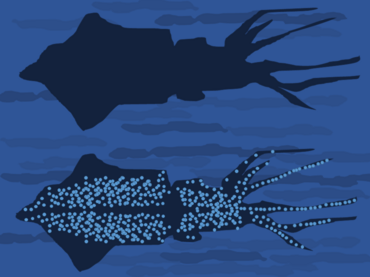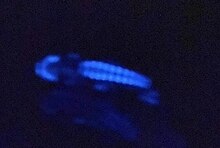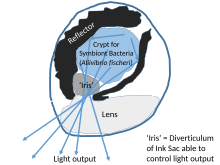Counter-illumination

Counter-illumination is a method of active camouflage seen in marine animals such as firefly squid and midshipman fish, and in military prototypes, producing light to match their backgrounds in both brightness and wavelength.
Marine animals of the mesopelagic (mid-water) zone tend to appear dark against the bright water surface when seen from below. They can camouflage themselves, often from predators but also from their prey, by producing light with bioluminescent photophores on their downward-facing surfaces, reducing the contrast of their silhouettes against the background. The light may be produced by the animals themselves, or by symbiotic bacteria, often Aliivibrio fischeri.
Counter-illumination differs from countershading, which uses only pigments such as melanin to reduce the appearance of shadows. It is one of the dominant types of aquatic camouflage, along with transparency and silvering. All three methods make animals in open water resemble their environment.
Counter-illumination has not come into widespread military use, but during the Second World War it was trialled in ships in the Canadian diffused lighting camouflage project, and in aircraft in the American Yehudi lights project.
In marine animals
Mechanism
Counter-illumination and countershading

In the sea, counter-illumination is one of three dominant methods of underwater camouflage, the other two being transparency and silvering.[1] Among marine animals, especially crustaceans, cephalopods, and fish, counter-illumination camouflage occurs where bioluminescent light from photophores on an organism's ventral surface is matched to the light radiating from the environment.[2] The bioluminescence is used to obscure the organism's silhouette produced by the down-welling light. Counter-illumination differs from countershading, also used by many marine animals, which uses pigments to darken the upper side of the body while the underside is as light as possible with pigment, namely white. Countershading fails when the light falling on the animal's underside is too weak to make it appear roughly as bright as the background. This commonly occurs when the background is the relatively bright ocean surface, and the animal is swimming in the mesopelagic depths of the sea. Counter-illumination goes further than countershading, actually brightening the underside of the body.[3][4]
Photophores

Counter-illumination relies on organs that produce light, photophores. These are roughly spherical structures that appear as luminous spots on many marine animals, including fish and cephalopods. The organ can be simple, or as complex as the human eye, equipped with lenses, shutters, colour filters and reflectors.[5]

In the Hawaiian bobtail squid (Euprymna scolopes) light is produced in a large and complex two-lobed light organ inside the squid's mantle cavity. At the top of the organ (dorsal side) is a reflector, directing the light downwards. Below this are containers (crypts) lined with epithelium containing light-producing symbiotic bacteria. Below those is a kind of iris, consisting of branches (diverticula) of its ink sac; and below that is a lens. Both the reflector and the lens are derived from mesoderm. Light escapes from the organ downwards, some of it travelling directly, some coming off the reflector. Some 95% of the light-producing bacteria are voided at dawn every morning; the population in the light organ then builds up slowly during the day to a maximum of some 1012 bacteria by nightfall: this species hides in sand away from predators during the day, and does not attempt counter-illumination during daylight, which would in any case require much brighter light than its light organ output. The emitted light shines through the skin of the squid's underside. To reduce light production, the squid can change the shape of its iris; it can also adjust the strength of yellow filters on its underside, which presumably change the balance of wavelengths emitted. The light production is correlated with the intensity of down-welling light but about one third as bright; the squid is able to track repeated changes in brightness.[6]
Matching light intensity and wavelength
At night, nocturnal organisms match both the wavelength and the light intensity of their bioluminescence to that of the down-welling moonlight and direct it downward as they swim, to help them remain unnoticed by any observers below.[6][7]

In the eyeflash squid (Abralia veranyi) a species which daily migrates between the surface and deep waters, a study showed that the light produced is bluer in cold waters and greener in warmer waters, temperature serving as a guide to the required emission spectrum. The animal has more than 550 photophores on its underside, consisting of rows of four to six large photophores running across the body, and many smaller photophores scattered over the surface. In cold water at 11 Celsius, the squid's photophores produced a simple (unimodal) spectrum with its peak at 490 nanometres (blue-green). In warmer water at 24 Celsius, the squid added a weaker emission (forming a shoulder on the side of the main peak) at around 440 nanometres (blue), from the same group of photophores. Other groups remained unilluminated: other species, and perhaps A. veranyi from its other groups of photophores, can produce a third spectral component when needed. Another squid, Abralia trigonura, is able to produce three spectral components: at 440 and at 536 nanometres (green), appearing at 25 Celsius, apparently from the same photophores; and at 470–480 nanometres (blue-green), easily the strongest component at 6 Celsius, apparently from a different group of photophores. Many species can in addition vary the light they emit by passing it through a choice of colour filters.[8]
Counterillumination camouflage halved predation among individuals employing it compared to those not employing it in the midshipman fish Porichthys notatus.[6][9]

Autogenic or bacteriogenic bioluminescence
The bioluminescence used for counter-illumination can be either autogenic (produced by the animal itself, as in pelagic cephalopods such as Vampyroteuthis, Stauroteuthis, and pelagic octopuses in the Bolitaenidae[10]) or bacteriogenic (produced by bacterial symbionts). The luminescent bacterium is often Aliivibrio fischeri, as for example in the Hawaiian bobtail squid.[6]
Purpose

Hiding from predators
Reducing the silhouette is primarily an anti-predator defence for mesopelagic (mid-water) organisms. The reduction of the silhouette from highly directional down-welling light is important, since there is no refuge in the open water, and predation occurs from below.[3][11][12] Many mesopelagic cephalopods such as the firefly squid (Watasenia scintillans), decapod crustaceans, and deep ocean fishes use counter-illumination; it works best for them when ambient light levels are low, leaving the diffuse down-welling light from above as the only light source.[6][3] Some deep water sharks, including Dalatias licha, Etmopterus lucifer, and Etmopterus granulosus, are bioluminescent, most likely for camouflage from predators that attack from beneath.[13]
Hiding from prey
Besides its effectiveness as a predator avoidance mechanism, counter-illumination also serves as an essential tool to predators themselves. Some shark species, such as the deepwater velvet belly lanternshark (Etmopterus spinax), use counter-illumination to remain hidden from their prey.[14] Other well-studied examples include the cookiecutter shark (Isistius brasiliensis), the marine hatchetfish, and the Hawaiian bobtail squid.[6] More than 10% of shark species may be bioluminescent, though some such as lantern sharks may use the light for signalling as well as for camouflage.[15]
Defeating counter-illumination camouflage
An animal camouflaged by counter-illumination is not completely invisible. A predator could resolve individual photophores on a camouflaged prey's underside, given sufficiently acute vision, or it could detect the remaining difference in brightness between the prey and the background. Predators with a visual acuity of 0.11 degrees (of arc) would be able to detect individual photophores of the Madeira lanternfish Ceratoscopelus maderensis at up to 2 metres (2.2 yd), and they would be able to see the general layout of the photophore clusters with poorer visual acuity. Much the same applies also to Abralia veranyi, but it was largely given away by its unlit fins and tentacles, which appear dark against the background from as far away as 8 metres (8.7 yd). All the same, the counter-illumination camouflage of these species is extremely effective, radically reducing their detectability.[2][a]
Military prototypes
Active camouflage in the form of counter-illumination has rarely been used for military purposes, but it has been prototyped in ship and aircraft camouflage from the Second World War onwards.[16][17][18]
For ships

Diffused lighting camouflage, in which visible light is projected on to the sides of ships to match the faint glow of the night sky, was trialled by Canada's National Research Council from 1941 onwards, and then by the Royal Navy, during the Second World War. Some 60 light projectors were mounted all around the hull and on the ships' superstructure such as the bridge and funnels. On average, the system reduced the distance at which a ship could be seen from a surfaced submarine by 25% using binoculars, or by 33% using the naked eye. The camouflage worked best on clear moonless nights: on such a night in January 1942, HMS Largs was not seen until it closed to 2,250 yards (2,060 m) when counter-illuminated, but was visible at 5,250 yards (4,800 m) unlighted, a 57% reduction in range.[16][19]
For aircraft

In 1916 the American artist Mary Taylor Brush experimented with camouflage on a Morane-Borel monoplane using light bulbs around the aircraft, and filed a 1917 patent that claimed she was "able to produce a machine which is practically invisible when in the air". The concept was not developed further during the First World War.[20]

The Canadian ship concept was trialled in American aircraft including B-24 Liberators and TBM Avengers in the Yehudi lights project, starting in 1943, using forward-pointing lamps automatically adjusted to match the brightness of the sky. The goal was to enable a radar-equipped, sea-search aircraft to approach a surfaced submarine to within 30 seconds from arrival before being seen, to enable the aircraft to drop its depth charges before the submarine could dive. There was insufficient electrical power available to illuminate the entire surface of the aircraft, and outboard lamps in the manner of diffused lighting camouflage would have interfered with the airflow over the aircraft's surface, so a system of forward-pointing lamps was chosen. These had a beam with a radius of 3 degrees, so pilots had to fly with the aircraft's nose pointed directly at the enemy. In a crosswind, this required a curving approach path, rather than a straight-line path with the nose pointed upwind. In trials in 1945, a counter-illuminated Avenger was not seen until 3,000 yards (2.7 km) from its target, compared to 12 miles (19 km) for an uncamouflaged aircraft.[17]
The idea was revisited in 1973 when an F-4 Phantom was fitted with camouflaging lights in the "Compass Ghost" project.[18]
Notes
- ^ The pattern of photophores may, in addition to matching background brightness, also serve to break up the animals' silhouettes, just as spots and stripes of coloured paint do in disruptive coloration, but in the absence of experimental evidence it is uncertain how useful this is: it would only help when the sea surface background was uneven.[2]
- ^ The effect may be seen by standing back a little from the image and half-closing the eyes. The upper image becomes indistinct where the lower image remains as a dark shape.
References
- ^ Herring, Peter (2002). The Biology of the Deep Ocean. Oxford: Oxford University Press. pp. 191–195. ISBN 9780198549567.
- ^ a b c Johnsen, Sönke; Widder, Edith A.; Mobley, Curtis D. (2004). "Propagation and Perception of Bioluminescence: Factors Affecting Counterillumination as a Cryptic Strategy". The Biological Bulletin. 207 (1): 1–16. doi:10.2307/1543624. ISSN 0006-3185. JSTOR 1543624. PMID 15315939. S2CID 9048248.
- ^ a b c Young, R.E,.; Roper, C.F.E. (1977). "Intensity Regulation of Bioluminescence during Countershading in Living midwater animals". Science. 191 (4231): 1046–1048. Bibcode:1976Sci...191.1046Y. doi:10.1126/science.1251214. PMID 1251214.
{{cite journal}}: CS1 maint: multiple names: authors list (link) - ^ Rowland, Hannah M. (2009). "Abbott Thayer to the present day: what have we learned about the function of countershading?". Philosophical Transactions of the Royal Society B. 364 (1516): 519–527. doi:10.1098/rstb.2008.0261. JSTOR 40485817. PMC 2674085. PMID 19000972.
- ^ "Cephalopod Photophore Terminology". Tolweb.org. Archived from the original on 20 August 2017. Retrieved 16 October 2017.
- ^ a b c d e f g Jones, B. W.; Nishiguchi, M. K. (2004). "Counterillumination in the Hawaiian bobtail squid, Euprymna scolopes Berry (Mollusca : Cephalopoda)" (PDF). Marine Biology. 144 (6): 1151–1155. Bibcode:2004MarBi.144.1151J. doi:10.1007/s00227-003-1285-3. S2CID 86576334. Archived (PDF) from the original on 11 June 2010.
- ^ Guerrero-Ferreira, R. C.; Nishiguchi, M. K. (2009). "Ultrastructure of light organs of loliginid squids and their bacterial symbionts: a novel model system for the study of marine symbioses". Vie et Milieu. 59 (3–4): 307–313. ISSN 0240-8759. PMC 2998345. PMID 21152248.
- ^ Herring, P. J.; Widder, E. A.; Haddock, S. H. D. (1992). "Correlation of bioluminescence emissions with ventral photophores in the mesopelagic squidAbralia veranyi (Cephalopoda: Enoploteuthidae)". Marine Biology. 112 (2): 293–298. Bibcode:1992MarBi.112..293H. doi:10.1007/BF00702474. ISSN 0025-3162. S2CID 4661478.
- ^ Harper, R.; Case, J. (1999). "Disruptive counterillumination and its anti-predatory value in the plainfish midshipman Porichthys notatus". Marine Biology. 134 (3): 529–540. Bibcode:1999MarBi.134..529H. doi:10.1007/s002270050568. S2CID 85386749.
- ^ Lindgren, Annie R.; Pankey, Molly S.; Hochberg, Frederick G.; Oakley, Todd H. (2012). "A multi-gene phylogeny of Cephalopoda supports convergent morphological evolution in association with multiple habitat shifts in the marine environment". BMC Evolutionary Biology. 12 (1): 129. Bibcode:2012BMCEE..12..129L. doi:10.1186/1471-2148-12-129. PMC 3733422. PMID 22839506.
- ^ Young. R. E; Roper. C. F. E. 1976. Bioluminescent countershading in Midwater Animals from living Squid. Science, New Series. Vol 191,4231: 1046-1048.
- ^ "Science & Nature - Sea Life - Ocean info - Counter-illumination". BBC. 2004-03-11. Retrieved 2012-10-03.
- ^ Mallefet, Jérôme; Stevens, Darren W.; Duchatelet, Laurent (26 February 2021). "Bioluminescence of the Largest Luminous Vertebrate, the Kitefin Shark, Dalatias licha: First Insights and Comparative Aspects". Frontiers in Marine Science. 8. Frontiers Media SA. doi:10.3389/fmars.2021.633582. ISSN 2296-7745.
- ^ Claes, Julien M.; Aksnes, Dag L.; Mallefet, Jérôme (2010). "Phantom hunter of the fjords: camouflage by counterillumination in a shark (Etmopterus spinax)" (PDF). Journal of Experimental Marine Biology and Ecology. 388 (1–2): 28–32. doi:10.1016/j.jembe.2010.03.009. Archived from the original (PDF) on 2011-09-27. Retrieved 2010-11-14.
- ^ Davies, Ella (26 April 2012). "Tiny sharks provide glowing clue". BBC. Archived from the original on 22 November 2012. Retrieved 12 February 2013.
- ^ a b Bush, Vannevar; Conant, James; et al. (1946). "Camouflage of Sea-Search Aircraft" (PDF). Visibility Studies and Some Applications in the Field of Camouflage. Office of Scientific Research and Development, National Defence Research Committee. pp. 225–240. Archived from the original (PDF) on October 23, 2013. Retrieved February 12, 2013.
- ^ a b Dann, Rich (2011). "Yehudi Lights" (PDF). Centennial of Naval Aviation. 3 (3): 15. Archived from the original (PDF) on 2011-10-07. Retrieved 2017-02-19.
the prototype Grumman XFF-1 .. was fitted with lights as an active camouflage method .. Counter-illumination was tested again in 1973, using a U.S. Air Force F-4C Phantom II with lights, under the name COMPASS GHOST
- ^ Admiralty (1942). Trial Report D.L. 126: DL Trials on HMS Largs in Clyde Approaches. The National Archives, Kew: Admiralty.
{{cite book}}:|work=ignored (help) - ^ D'Alto, Nick (2016). "Inventing the Invisible Airplane: When camouflage was fine art". Air & Space Magazine. Retrieved 9 March 2020.
External links
- Scientific American: 10 Bioluminescent Creatures
- Science Magazine: Bioluminescence in Mesopelagic Squid
- Nova: Science Now: Glowing in the Dark (Squid Abralia veranyi belly lights)


